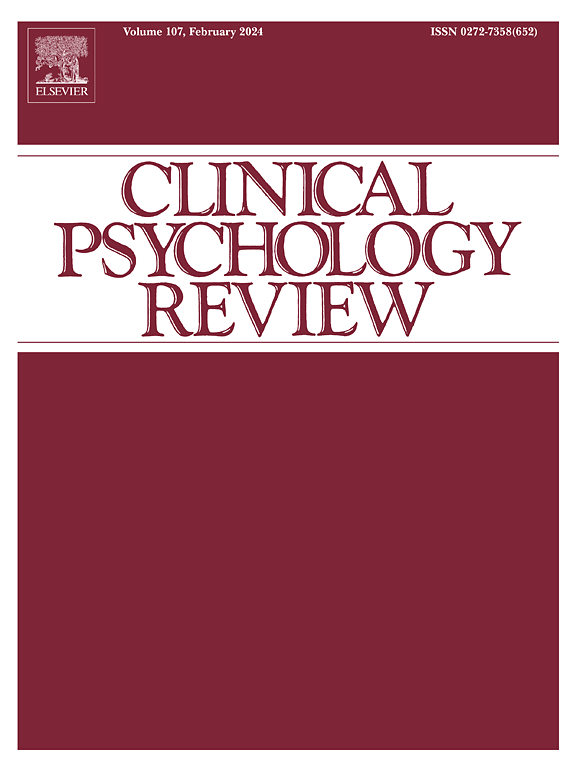Jumping to conclusions and delusional ideation: A systematic review and meta-analysis across the psychosis continuum
IF 12.2
1区 心理学
Q1 PSYCHOLOGY, CLINICAL
引用次数: 0
Abstract
We applied a two-stage Bayesian analysis to examine the relationship between the jumping to conclusions (JTC) bias (measured on the beads, box, fishing, and/or survey tasks) and delusional ideation (measured on the Peters et al. Delusions Inventory or the Community Assessment of Psychic Experiences). MEDLINE, PsycINFO, Scopus, Web of Science, and five previous JTC reviews were searched for eligible studies published between 1988 and December 2024. Risk of bias was assessed using an adapted version of the Agency for Healthcare Research and Quality assessment tool. Forty-two studies (n = 7604) were identified as meeting inclusion criteria, with four subgroups: general population (n = 7538), psychosis with current delusions (n = 449), psychosis without current delusions (n = 29), and clinical control (n = 77). Our first analysis presented a meta-analysis of correlations between delusional ideation and JTC. Our second analysis presented a zero-inflated Poisson regression, assessing change in JTC across variable delusional ideation scores. Impact of data quality was assessed in both analyses. No meaningful relationships between JTC and delusional ideation were found in the full dataset or any subgroup, but the subgroup with current delusions showed a relatively greater JTC bias than the general population subgroup. Data-quality procedures did not impact results. Overall, results suggest that the JTC bias is not related to delusional ideation, or indexes of delusional ideation and/or JTC used in this meta-analysis are poor measures of these constructs. Our results did not assess delusional severity, thus interpretations in clinical populations are limited. PROSPERO https://www.crd.york.ac.uk/PROSPERO/view/CRD42021266402.
妄下结论和妄想症:横跨精神病连续体的系统回顾和荟萃分析
我们应用了两阶段贝叶斯分析来检验跳跃到结论(JTC)偏差(在珠子、盒子、钓鱼和/或调查任务上测量)和妄想观念(在彼得斯等人上测量)之间的关系。妄想清单或精神体验的社区评估)。检索了MEDLINE、PsycINFO、Scopus、Web of Science和5篇JTC先前的综述,检索了1988年至2024年12月间发表的符合条件的研究。使用医疗保健研究和质量评估机构的改进版本评估偏倚风险。42研究(n = 7604)被确定为满足入选标准,与四子组:一般人群(n = 7538),精神病与当前错觉(n = 449),精神病没有当前妄想(n = 29),和临床控制(n = 77)。我们的第一个分析提出了妄想和JTC之间相关性的元分析。我们的第二个分析提出了零膨胀泊松回归,评估了不同妄想意念得分的JTC变化。两项分析均评估了数据质量的影响。在完整的数据集或任何亚组中都没有发现JTC与妄想之间有意义的关系,但患有当前妄想的亚组比一般人群亚组显示出相对更大的JTC偏差。数据质量程序不影响结果。总的来说,结果表明JTC偏倚与妄想意识无关,或者在本荟萃分析中使用的妄想意识和/或JTC指数是这些构念的不良衡量指标。我们的结果没有评估妄想的严重程度,因此在临床人群中的解释是有限的。普洛斯彼罗[被删除了]。
本文章由计算机程序翻译,如有差异,请以英文原文为准。
求助全文
约1分钟内获得全文
求助全文
来源期刊

Clinical Psychology Review
PSYCHOLOGY, CLINICAL-
CiteScore
23.10
自引率
1.60%
发文量
65
期刊介绍:
Clinical Psychology Review serves as a platform for substantial reviews addressing pertinent topics in clinical psychology. Encompassing a spectrum of issues, from psychopathology to behavior therapy, cognition to cognitive therapies, behavioral medicine to community mental health, assessment, and child development, the journal seeks cutting-edge papers that significantly contribute to advancing the science and/or practice of clinical psychology.
While maintaining a primary focus on topics directly related to clinical psychology, the journal occasionally features reviews on psychophysiology, learning therapy, experimental psychopathology, and social psychology, provided they demonstrate a clear connection to research or practice in clinical psychology. Integrative literature reviews and summaries of innovative ongoing clinical research programs find a place within its pages. However, reports on individual research studies and theoretical treatises or clinical guides lacking an empirical base are deemed inappropriate for publication.
 求助内容:
求助内容: 应助结果提醒方式:
应助结果提醒方式:


